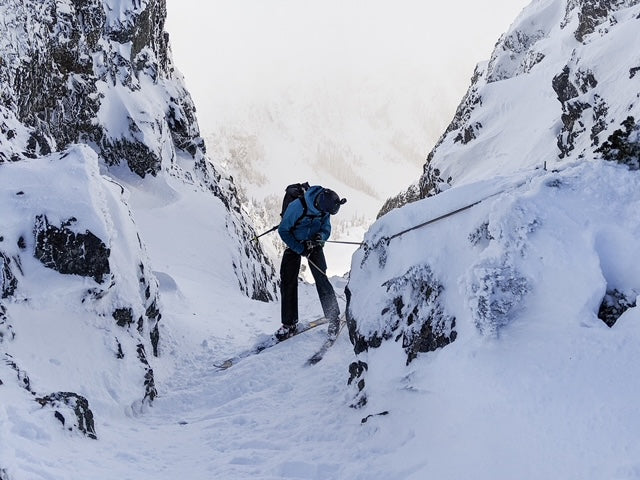
Ropes For Ski-Mountaineering: Which One to Get?
Eric Carter is a professional ski mountaineer and coach for alpine athletes based in Squamish, BC. Follow him on Instagram
While I am pretty adamant about a light and fast philosophy, I also find a rope in my pack more and more often. As skiing gets more advanced, whether it's glaciers or technical alpine terrain, a rope becomes a more common tool. That old 60 meter dynamic rock climbing rope that you break out of the gear bin for traverses and glacier trips will certainly get the job done. However, it will weigh a ton. You're also taking a risk that if you only have one long, heavy rope in your party, and it falls in the crevasse, you're out of luck!
 Modern ski mountaineering ropes are 6mm and pack down to the size of your folded skins. They're not just lighter, but also more cut resistant and more water resistant that traditional nylon ropes. There's several specialized models available from various manufacturers but they each have pros and cons. I've reviewed each of the options available in North America to help you sort out the differences.
Modern ski mountaineering ropes are 6mm and pack down to the size of your folded skins. They're not just lighter, but also more cut resistant and more water resistant that traditional nylon ropes. There's several specialized models available from various manufacturers but they each have pros and cons. I've reviewed each of the options available in North America to help you sort out the differences.

Petzl Rad Line
This rope is the lightest, so for the weight weenies, this is the top choice. It's also the most expensive, so you pay a bit more to save those last few grams. RAD Lines are rated for rappelling, and for glacier travel and rescue but they aren't to be used for belaying or climbing.

Mammut Glacier Cord Dry
This rope is dry treated, making it a bit heavier but also probably slightly more abrasion resistant (though not actually much more water resistant). It's slightly less expensive though, so you get a bit of a trade there! It's rated for the same uses as the RAD Line and both can be used with rope clamps like the Tibloc or Micro-Traxion.

Edelrid Rap Line Protect Pro Dry
The is also dry treated and the heaviest of the three. The price is lower, with a 60m only ~$30 more than a 30m RAD. The big difference though is that when used in twin configuration (clipping two strands together through each piece of pro), the RLP has a dynamic "safety reserve" allowing for 2 UIAA falls. In other words, in a pinch, it can be used for belaying and climbing, plus rappelling and glacier travel.
 In short, I'd go for the Petzl if weight is the most important thing. The Mammut is the slightly more budget option that's nearly as light. Grab the Edelrid if you're ok with something heavier that will give you the ability to lead short pitches of climbing (only a 30m pitch when using a 60m rope folded in twin configuration).
In short, I'd go for the Petzl if weight is the most important thing. The Mammut is the slightly more budget option that's nearly as light. Grab the Edelrid if you're ok with something heavier that will give you the ability to lead short pitches of climbing (only a 30m pitch when using a 60m rope folded in twin configuration).
To see my in-depth review of each option, as well as an overview of the situations we use these ropes for ski mountaineering, and an intro to the specialized gear we use with them, check out the video below!



